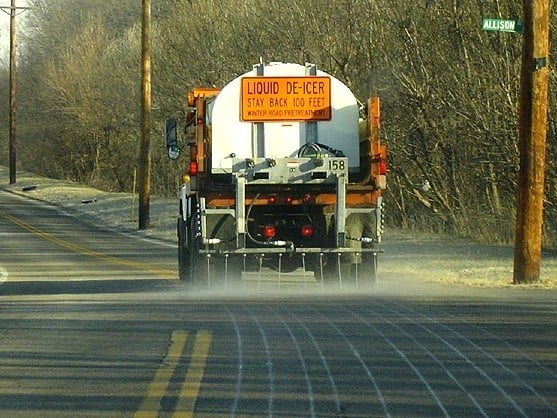
 Is brine better than salt for keeping Canada’s roads safe?
Is brine better than salt for keeping Canada’s roads safe?
A lot of towns and cities across Canada, most likely including the one in which you live, have been using a brine mixture instead of salt or sand to try and increase the safety of our streets and highways. The practice has been on the rise over the past decade or so.
Cities like Toronto, Vancouver, Winnipeg, and Calgary have been using a brine (salt water) mix to treat roads before storms hit and to remove ice above certain temperatures.
The use of salt on roads has been around since about 1941, when New Hampshire became the first state to adopt it for general use, instead of using sand exclusively. And it has proven safe. A study conducted at Marquette University in Milwaukee, Wisconsin, found that salting roads reduces crashes by 88 percent, injuries by 85 percent, and accident costs by 85 percent.
Salt or brine for roads? It’s not an easy question to answer
But salt is not a cure-all, pardon the pun. Spreading it on roads decreases the freezing point of water, but when the temperature dips below minus ten degrees Celsius, the salt won’t activate. When roads are coated with brine ahead of snowfall, however, it does wonders in preventing the ice and snow from even collecting. And because it uses less salt it’s also better for the environment: a 2001 report from Environment Canada found that road salts were entering the environment in amounts large enough to pose a risk to plants, animals, birds and groundwater.
Brines are a mixture of around 20% salt and 80% water mixed with other de-icing chemicals, which vary from region to region. But using these mixes does have some downsides. For starters, they can eat your car alive, and they can cause bridges to rust.
In Prince Edward Island during the winter of 2011-2012, the brine mixture worked so well for removing ice and snow on highways alongside the money saved from using less salt, the province decided to make it a permanent addition. Looking out my window right now I can see the dried brine on the roads in preparation for the expected snowfall on Monday.
Brine works because it gets into places that salt cannot and spreads much more evenly, reducing waste. But brine and your vehicle are mortal enemies because it is much more corrosive than just regular everyday road salt and has a much lower activation point. So, when you drive over it and it gets onto the underside of your vehicle it can stick there until activated by water some time later. If you live in a city where brine is sprayed on roads you may want to get your car washed a bit more than you normally would.
There’s one more unusual weapon being used in the fight against slippery roads: beets. As temperatures begin to get colder than -20 Celsius, brine tends to freeze before it can be applied, so the city of Toronto has been mixing its salt with beet juice, which doesn’t freeze as easily. The beet juice and rock salt mixture works to minus 30 and probably below. And since the salt is wet it won’t scatter across the road as easily and end up in ditches where it goes to waste. The beet juice and rock salt mixture is more expensive than the regular brine mixture but it rarely sees much use.
Brines have become almost as accurate for regional identification as food recipes. In Wisconsin, rock salt mixed with cheese brine has saved cities as much as 40 per cent over regular salt use. Other brines are derived from vodka, pickles, even molasses.
Leave a Reply
You must be logged in to post a comment.




 Share
Share Tweet
Tweet Share
Share




Comment